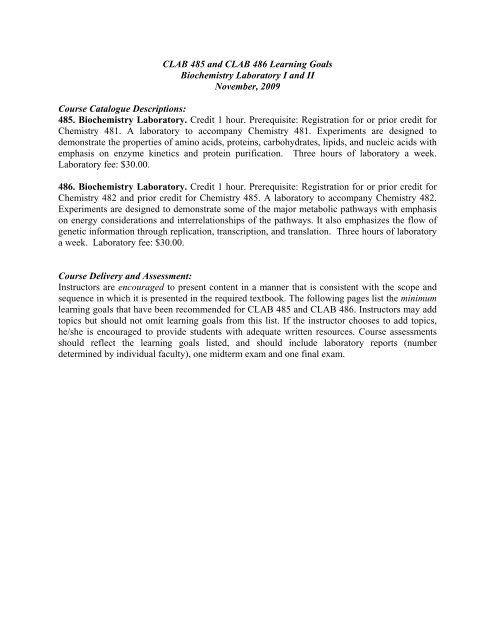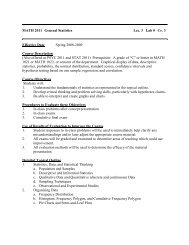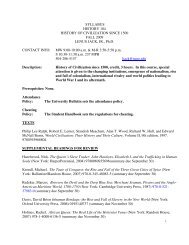CLAB 485 and CLAB 486 Learning Goals Biochemistry Laboratory I ...
CLAB 485 and CLAB 486 Learning Goals Biochemistry Laboratory I ...
CLAB 485 and CLAB 486 Learning Goals Biochemistry Laboratory I ...
You also want an ePaper? Increase the reach of your titles
YUMPU automatically turns print PDFs into web optimized ePapers that Google loves.
<strong>CLAB</strong> <strong>485</strong> <strong>and</strong> <strong>CLAB</strong> <strong>486</strong> <strong>Learning</strong> <strong>Goals</strong><br />
<strong>Biochemistry</strong> <strong>Laboratory</strong> I <strong>and</strong> II<br />
November, 2009<br />
Course Catalogue Descriptions:<br />
<strong>485</strong>. <strong>Biochemistry</strong> <strong>Laboratory</strong>. Credit 1 hour. Prerequisite: Registration for or prior credit for<br />
Chemistry 481. A laboratory to accompany Chemistry 481. Experiments are designed to<br />
demonstrate the properties of amino acids, proteins, carbohydrates, lipids, <strong>and</strong> nucleic acids with<br />
emphasis on enzyme kinetics <strong>and</strong> protein purification. Three hours of laboratory a week.<br />
<strong>Laboratory</strong> fee: $30.00.<br />
<strong>486</strong>. <strong>Biochemistry</strong> <strong>Laboratory</strong>. Credit 1 hour. Prerequisite: Registration for or prior credit for<br />
Chemistry 482 <strong>and</strong> prior credit for Chemistry <strong>485</strong>. A laboratory to accompany Chemistry 482.<br />
Experiments are designed to demonstrate some of the major metabolic pathways with emphasis<br />
on energy considerations <strong>and</strong> interrelationships of the pathways. It also emphasizes the flow of<br />
genetic information through replication, transcription, <strong>and</strong> translation. Three hours of laboratory<br />
a week. <strong>Laboratory</strong> fee: $30.00.<br />
Course Delivery <strong>and</strong> Assessment:<br />
Instructors are encouraged to present content in a manner that is consistent with the scope <strong>and</strong><br />
sequence in which it is presented in the required textbook. The following pages list the minimum<br />
learning goals that have been recommended for <strong>CLAB</strong> <strong>485</strong> <strong>and</strong> <strong>CLAB</strong> <strong>486</strong>. Instructors may add<br />
topics but should not omit learning goals from this list. If the instructor chooses to add topics,<br />
he/she is encouraged to provide students with adequate written resources. Course assessments<br />
should reflect the learning goals listed, <strong>and</strong> should include laboratory reports (number<br />
determined by individual faculty), one midterm exam <strong>and</strong> one final exam.
<strong>CLAB</strong> <strong>485</strong> <strong>Learning</strong> <strong>Goals</strong><br />
<strong>Biochemistry</strong> <strong>Laboratory</strong> I<br />
Pipettors <strong>and</strong> st<strong>and</strong>ard curves<br />
• To underst<strong>and</strong> <strong>and</strong> use P-20, P-100 <strong>and</strong> P-1000 micropipettors by repetitive pipetting<br />
• To make dilutions of p-nitrophenol <strong>and</strong> perform spectroscopic analysis to identify the concentration of<br />
an unknown<br />
• To gain experience with the UV/VIS microplate reader<br />
Buffers <strong>and</strong> buffering capacity<br />
• To make solutions containing multiple compounds<br />
• To make a buffer solution at a specific pH using the Henderson-Hasselbalch equation<br />
• To investigate the ability of a buffer solution to withst<strong>and</strong> the addition of acid <strong>and</strong>/or base<br />
• To determine the theoretical change in pH of a buffer solution upon the addition of acid <strong>and</strong>/or base<br />
using the Henderson-Hasselbalch equation<br />
• To investigate the relationship of pK to buffering capacity of acetic acid<br />
Amino acids: Titration, pK, ion exchange <strong>and</strong> pI<br />
• To relate the concept of pK to biological molecules (amino acids <strong>and</strong> proteins)<br />
• To determine the pK values of an amino acid by performing an acid/base titration<br />
• To separate amino acids using the process of paper chromatography to identify a dipeptide<br />
• To contrast the ninhydrin reaction for primary <strong>and</strong> secondary amines<br />
• To compare the spectral scans of aromatic amino acids in the UV range<br />
• To separate amino acids via ion exchange chromatography <strong>and</strong> predict the elution order with increasing<br />
pH<br />
• To determine the pI of an amino acid<br />
Beer-Lambert Law <strong>and</strong> proteins assays<br />
• To demonstrate the relationship between absorbance <strong>and</strong> concentration using extinction coefficients<br />
• To compare <strong>and</strong> contrast the Bradford <strong>and</strong> BCA methods of protein quantification<br />
• To generate st<strong>and</strong>ard curves using bovine serum albumin as a protein<br />
• To determine the concentration of a protein using the Bradford <strong>and</strong> BCA methods for protein assays<br />
Horseradish peroxidase: Affinity chromatography, gel filtration, <strong>and</strong> polyacrylamide electrophoresis<br />
• To underst<strong>and</strong> the concept of lectins as they relate to horseradish peroxidase<br />
• To purify horseradish peroxidase using a Concanavalin A affinity column<br />
• To demonstrate the concept of competitive elution of a protein from an affinity column<br />
• To collect fractions <strong>and</strong> determine absorbance at various wavelengths<br />
• To perform a enzyme-coupled assay using ABTS as an electron donor<br />
• To use extinction coefficients in the conversion of Δabs/min to μmol/min (rate)<br />
• To perform the calculations necessary (activity, specific activity, total activity, yield, <strong>and</strong> fold<br />
purification) for the creation of a protein purification table<br />
• To create column profiles consisting of double y-axis graphs<br />
• To determine the molecular weight of horseradish peroxidase using gel filtration<br />
• To underst<strong>and</strong> the concept of SDS-Polyacrylamide Gel Electrophoresis <strong>and</strong> determine an accurate<br />
molecular weight for horseradish peroxidase<br />
Enzyme kinetics: K m , V max , inhibition, K i , <strong>and</strong> substrate specificity<br />
• To experimentally relate Michaelis-Menten graphs to Lineweaver-Burk graphs<br />
• To underst<strong>and</strong> the concept of reversible enzyme inhibition
• To develop an enzyme assay to determine the concentration of enzyme appropriate for a specified<br />
Δabs/minute<br />
• To develop an enzyme assay to determine the concentration of inhibitor appropriate for a specified<br />
reduction in the rate<br />
• To create an assay sufficient to provide both Michaelis-Menten <strong>and</strong> Lineweaver-Burk plots<br />
• To experimentally determine the values of K m <strong>and</strong> V max using the generated data<br />
• To experimentally show substrate specificity given both D- <strong>and</strong> L-isomers of a substrate<br />
• To experimentally determine the type of irreversible inhibition <strong>and</strong> the value of K i
<strong>CLAB</strong> <strong>486</strong> <strong>Learning</strong> <strong>Goals</strong><br />
<strong>Biochemistry</strong> <strong>Laboratory</strong> II<br />
Nucleotides, hyperchromic effect, <strong>and</strong> DNA melting<br />
• To investigate the UV spectroscopy of nucleotide bases in RNA <strong>and</strong> DNA<br />
• To investigate the hyperchromic effect of dsDNA<br />
• To investigate the effect of heat on dsDNA<br />
• To investigate the effect of DNase on DNA structure<br />
Plasmid DNA Isolation<br />
• To investigate the effects of SDS on cell membrane rupture <strong>and</strong> cell lysis<br />
• To purify plasmid DNA from lysed cells using silica column<br />
• To determine the concentration of plasmid DNA using UV spectroscopy<br />
Restriction Analysis <strong>and</strong> Gel Electrophoresis of Plasmid DNA<br />
• To use three endonucleases to cleave plasmid DNA <strong>and</strong> control DNA<br />
• To separate digests relative to native plasmid DNA by gel electrophoresis, including pouring agarose<br />
gels.<br />
• To analyze the size of DNA <strong>and</strong> DNA fragments<br />
• To predict the size of DNA fragments <strong>and</strong> the agreement between theory <strong>and</strong> practice.<br />
Polymerase Chain Reaction (PCR) <strong>and</strong> Amplification of p-Glo Gene<br />
• To use Thermus acquatitus DNA polymerase to amplify the pGlo gene.<br />
• To purify amplified DNA<br />
• To analyze amplified DNA by agarose gel electrophoresis <strong>and</strong> endonuclease mapping.<br />
pGlo Expression<br />
• To transform a pGlo plasmid into E. coli<br />
• To investigate the effects of arabinose <strong>and</strong> ampicilin on growth of pGlo-transformed <strong>and</strong> control E. coli<br />
• To investigate the effects of arabinose <strong>and</strong> ampicilin on <strong>and</strong> expression of GFP in transformed cells.<br />
Green Fluorescent Protein (GFP) purification <strong>and</strong> polyacrylamide gel electrophoresis<br />
• To prepare overnight culture of E. coli transformed with pGlo<br />
• To lyse E. coli enriched in GFP-enriched cells.<br />
• To purify GFP by hydrophobic interaction chromatography<br />
Polyacrylamide Gel Electrophoresis <strong>and</strong> Western Blot Analysis of Green Fluorescent Protein<br />
• To determine the relative molecular mass of GRP using SDS PAGE<br />
• To identify the presence of GFP using western blot analysis of SDS PAGE gels<br />
Glycolysis –Design, Preparation, <strong>and</strong> Analysis (3 labs)<br />
• To design experiments to prove the final three steps of the glycolytic pathway.<br />
• To prepared reagents for these designed experiments<br />
• To prove experimentally the last three steps of glycolysis<br />
Allosteric control of isocitrate dehydrogenase I<br />
• To design an assay for isocitrate dehydrgenase from yeast.<br />
• To generate dose-response curves for IDH in the absence <strong>and</strong> presence of allosteric activators <strong>and</strong><br />
inhibitors<br />
• To analyze the effects of allosteric activators <strong>and</strong> inhibitors on IDH Km <strong>and</strong> Vmax kinetic constants.






